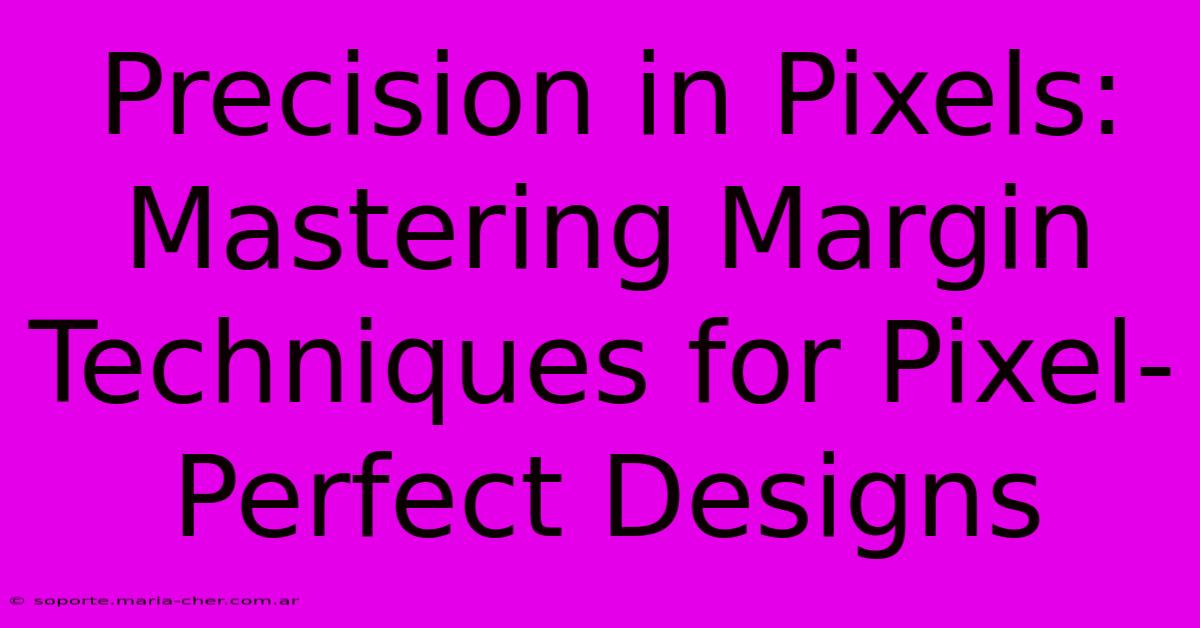Precision In Pixels: Mastering Margin Techniques For Pixel-Perfect Designs

Table of Contents
Precision in Pixels: Mastering Margin Techniques for Pixel-Perfect Designs
Achieving pixel-perfect designs is the holy grail for many web designers and developers. It's about that satisfying feeling of absolute control, ensuring every element sits exactly where you intend it to, resulting in a polished and professional final product. A key component of this precision lies in mastering margin techniques. This article will delve into the intricacies of margins, providing you with the knowledge and strategies to conquer pixel-perfect layouts.
Understanding Margins: The Foundation of Spacing
Margins define the space outside an element's border. Unlike padding (which controls the space inside the border), margins dictate the spacing between elements, significantly impacting the overall layout's visual harmony. Understanding how margins work is the first step towards pixel-perfect precision.
Margin Properties: A Deep Dive
Various CSS properties control margins:
margin-top: Sets the top margin.margin-right: Sets the right margin.margin-bottom: Sets the bottom margin.margin-left: Sets the left margin.margin: A shorthand property to set all four margins at once (e.g.,margin: 10px;sets all margins to 10 pixels). You can also use different values for each side (e.g.,margin: 10px 20px 30px 40px;sets top, right, bottom, and left margins respectively).
Mastering Pixel-Perfect Margins: Techniques and Tricks
Achieving pixel-perfect designs often requires going beyond simple margin assignments. Here are some advanced techniques to refine your control:
1. Utilizing the Box Model:
The box model is fundamental. Understanding how the content area, padding, border, and margin interact is crucial for accurate calculations. Remember that margins collapse in certain situations (adjacent margins of block-level elements often combine into a single margin). Be mindful of this when trying to achieve specific spacing.
2. Working with Different Units:
While pixels are ideal for pixel-perfect control, you might occasionally use other units like em or rem for responsiveness. However, for the most precise control, stick with pixels when striving for pixel perfection.
3. Debugging and Inspecting:
Your browser's developer tools are invaluable. Use the inspector to precisely measure element dimensions and margins to identify and correct any discrepancies. Pay close attention to unexpected margin collapses or browser-specific rendering quirks.
4. Using Flexbox and Grid:
Modern layout techniques like Flexbox and Grid offer powerful tools for precise element placement. These methods simplify complex layouts, reducing the reliance on intricate margin adjustments, and provide better control over alignment and distribution.
Advanced Margin Strategies for Complex Layouts
For complex designs, more strategic approaches are necessary:
1. Calculating Margins Based on Element Dimensions:
Often, margins need to be dynamically calculated based on other element sizes. This usually involves JavaScript or CSS preprocessors like Sass or Less, which allow for variable usage and calculations.
2. Using CSS Variables (Custom Properties):
CSS variables provide an excellent way to centralize and manage margin values. Changing a single variable updates all elements that use it, ensuring consistency and simplifying maintenance.
Avoiding Common Pitfalls:
- Margin Collapse: Be aware of how margin collapse affects your layout. Techniques like adding padding or using
overflow: auto;can help prevent unexpected results. - Browser Inconsistencies: Slight variations in rendering can occur across different browsers. Thorough testing is crucial.
- Over-reliance on Margins: For complex layouts, consider utilizing Flexbox or Grid for cleaner and more maintainable code.
Conclusion: The Pixel-Perfect Pursuit
Mastering margin techniques is essential for achieving pixel-perfect designs. By understanding the fundamentals, employing advanced strategies, and diligently debugging, you can create visually stunning and precisely controlled layouts. Remember that precision is a journey, requiring patience, attention to detail, and a willingness to experiment. Embrace the process, and your pixel-perfect designs will reward you with a polished, professional aesthetic.

Thank you for visiting our website wich cover about Precision In Pixels: Mastering Margin Techniques For Pixel-Perfect Designs. We hope the information provided has been useful to you. Feel free to contact us if you have any questions or need further assistance. See you next time and dont miss to bookmark.
Featured Posts
-
Pom Pom Alchemy The Science Behind Creating Perfect Puffy Ornaments
Feb 05, 2025
-
The Dark Art Of Persuasion Uncovering The Decision Labs Tactics
Feb 05, 2025
-
Privacy Paradise Simple Steps To Create A No Soliciting Zone
Feb 05, 2025
-
Transform Your Austin Oasis With Perry Homes Architectural Wonders
Feb 05, 2025
-
Witness History Unfold Before Your Eyes Ai Animates Vintage Photos
Feb 05, 2025
